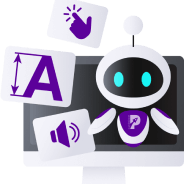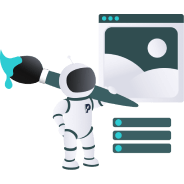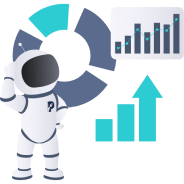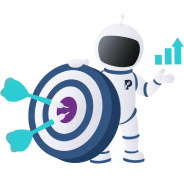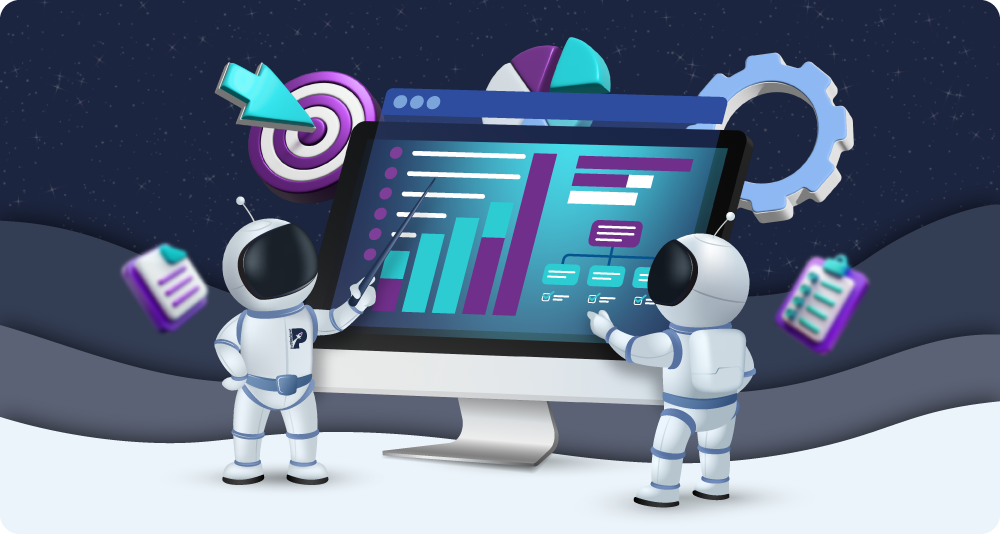

Project Management in Digital Campaigns: 8 Tools and Tactics for Success
Digital projects and campaigns often come with a range of challenges that can affect their success. And in lots of cases, problems can be smoothed over by the use of a project management tool.
One of the primary issues is the complexity of coordination across different teams, platforms, and channels. When campaigns involve various stakeholders, (e.g., designers, marketers, and developers), there can be miscommunication and delays. However, project management tools allow stakeholders to communicate about their efforts, give updates, and adjust timelines when needed.
There’s also the issue of measuring and analysing the success of digital campaigns. With so many metrics to track across various platforms, it can be difficult to make sense of the data and extract actionable insights. Project management tools allow you to integrate data from different sources into a cohesive reporting framework, helping you to accurately assess performance and optimise future campaigns.
Projects can also be made difficult by client expectations and real-time feedback, often leading to last-minute or unexpected changes. This can be stressful, but project management tools allow for a feedback loop and communication between stakeholders in real time so that campaigns can be adjusted as quickly as possible.
By centralising communication, tasks, feedback, and resources, project management tools alleviate many of the challenges common to digital campaigns. This blog will explore 8 popular tools and give you tips for managing projects effectively.
Read on to learn how you can streamline collaboration, avoid miscommunication, track progress, integrate data, create automations, and manage client expectations effectively.
8 tools for project management
There are many project management tools on the market, each offering unique features tailored to different business needs. The best tool for your business will depend on factors such as team size, project complexity, and specific campaign goals.
Whether you’re looking for enhanced collaboration, detailed analytics, or automation, selecting the right tool can make a significant difference in your campaign’s success. Let’s explore a few now:
1. ClickUp
Known for its versatility, ClickUp provides workflow automations, real-time analytics, and customisable templates. It integrates with over 1,000 tools, making it an excellent choice for managing end-to-end marketing campaigns.
ClickUp is particularly well-suited for teams managing complex projects that require detailed task management and collaboration. It works best for marketing, IT, and creative projects, where tracking multiple tasks, deadlines, and workflows is essential. While it’s an excellent tool for small to mid-sized teams, larger enterprises may benefit from the additional security and customisation features offered in higher-tier plans.
ClickUp offers several pricing plans to accommodate different business sizes and requirements:
- The Free Forever plan is ideal for freelancers and small businesses, providing unlimited users, tasks, and projects with basic features.
- The Unlimited Plan costs $7 per user per month (billed annually) and is suitable for growing small businesses, offering features like unlimited storage and integrations.
- The Business Plan ($12 per user per month) is best for mid-sized teams, providing advanced features such as timelines and workload management.
- For larger enterprises, the Business Plus ($19 per user per month) and Enterprise (custom pricing) plans offer even more customisation and security features, such as API access and HIPAA compliance.
When using ClickUp, businesses should take advantage of its customisation options, such as automations and custom fields, to tailor workflows to your team’s specific needs.
However, be prepared for a learning curve; the platform’s many features can feel overwhelming at first. Additionally, for better communication, consider integrating it with third-party communication tools, as ClickUp’s native collaboration features may not be sufficient for all teams.
2. HubSpot
HubSpot is not a dedicated project management tool like ClickUp. It’s more focused on managing customer relationships, marketing automation, and sales processes, but it can be adapted to manage certain projects, especially those directly tied to customer-facing activities like marketing campaigns or sales initiatives.
As a powerful CRM (customer relationship management), HubSpot excels in tracking marketing campaigns and analytics, offering features like dynamic personalisation and omnichannel automation. It’s ideal for businesses needing advanced marketing automations.
HubSpot is particularly well-suited for small to mid-sized businesses aiming to scale quickly and improve their customer lifecycle management. Its versatility makes it ideal for projects across sales, marketing, and customer service, providing tools for everything from email marketing and pipeline management to customer support and ticketing.
HubSpot offers a range of pricing plans tailored to different business needs:
- The Starter plan starts at $20 per month and is suitable for small businesses looking to access basic sales, marketing, and CRM tools.
- The Professional plan, at $890 per month, adds advanced features such as marketing automation, custom reports, and more detailed analytics, making it ideal for growing mid-sized businesses.
- For large enterprises, the Enterprise plan starts at $3,600 per month, offering top-tier functionality like advanced reporting and predictive lead scoring.
To get the most out of HubSpot, it’s essential to invest time in setting up its automation and CRM features effectively. For more advanced users, the platform’s higher-tier plans offer deep customisation options, but these can require a steep learning curve. HubSpot also charges additional fees for onboarding at the Professional and Enterprise levels, so be prepared for those upfront costs as you scale.
3. Hootsuite
Hootsuite is a tool focused on social media campaigns, allowing for streamlined content scheduling, monitoring, and analytics across various social platforms. It’s particularly useful for managing multiple accounts but lacks advanced project management features.
Hootsuite offers three primary subscription plans:
- The Professional plan costs £89 per month (billed annually) and includes one user with access to 10 social media accounts, unlimited post scheduling, and analytics.
- The Team plan is priced at £249 per month and supports up to three users managing 20 social accounts. It adds features like automated link tracking and shared social content calendars.
- The Enterprise Custom plan, with custom pricing, caters to larger teams and supports up to five users with advanced features such as user permissions, approval workflows, and campaign planning.
Hootsuite is best suited for small to mid-sized businesses and agencies that manage multiple social media accounts and need efficient content scheduling and engagement tools. It’s particularly beneficial for businesses focusing on social media management projects,
including content creation, audience engagement, and advertising campaigns across platforms like Facebook, Instagram, and LinkedIn.
To get the most out of Hootsuite, leverage its integrations with tools like Canva and Grammarly to enhance content creation and management. Utilise its advanced analytics to track performance and optimise your social media strategy.
While Hootsuite is feature-rich, be aware that some capabilities, like advanced listening and reporting, require add-ons or higher-tier plans. You might like to start with a 30-day free trial to determine which plan fits your needs best.
4. Asana
Asana is a super popular and easy-to-use tool that helps teams organise tasks, set timelines, and track progress, Asana is ideal for campaign coordination and managing multiple projects at once.
Asana is well-suited for businesses of all sizes, but it shines for mid-sized to large teams handling complex workflows and cross-team projects. It’s particularly effective for projects that require detailed task tracking, reporting, and collaboration across multiple departments, such as marketing, IT, and product development.
When using Asana, it’s essential to take advantage of its automation features and custom workflows to streamline your project management. The platform’s user-friendly interface makes it easy to onboard new team members, but as your projects grow in complexity, you’ll find that Asana’s advanced features, such as rule-based automation and workload management, become indispensable.
Asana offers several subscription plans:
- The Personal plan is free and best for individuals or small teams with up to 10 members, offering core features like task management, board views, and unlimited projects.
- The Starter plan costs £9.49 per user per month (billed annually) and adds advanced features like timelines, workflow automation, and reporting, making it ideal for growing teams.
- The Advanced plan, at £20.99 per user per month, includes portfolio management, workload views, and advanced integrations with tools like Salesforce and Adobe Creative Cloud, catering to larger teams and complex projects.
- For enterprises needing more customisation and security features, the Enterprise plan offers tailored pricing with features like SAML, data export, and HIPAA compliance.
5. Teamwork
Teamwork stands out with its flexibility in data hosting, making it ideal for teams that require compliance with international data protection regulations. It also offers strong customer support and resource management.
Teamwork offers a variety of subscription plans:
- The Free Forever plan is suitable for small teams, offering core project management features for up to 5 users and 2 active projects.
- The Deliver plan costs £10.99 per user per month (billed annually) and is ideal for small to medium-sized businesses, providing features like 100GB of storage and up to 300 projects.
- The Grow plan is priced at £19.99 per user per month, supporting larger teams with 250GB of storage, advanced reporting, and up to 600 projects.
- The Scale plan, £54.99 per user per month, includes advanced features like resource scheduling, profitability management, and custom reports.
Teamwork is suited to both small and large businesses, particularly those that manage client work, such as agencies, consultancies, and creative teams. It’s great for projects that require detailed task tracking, time management, and collaboration across teams. Its features like built-in time tracking, project templates, and resource management make it ideal for managing complex client-based projects.
To get the most out of Teamwork, take advantage of its customisation capabilities, such as creating custom fields, templates, and automations to streamline workflows. The platform is user-friendly, but it can become overwhelming due to the extensive customisation options, so it’s essential to set up clear processes from the start to prevent distractions.
6. Basecamp
Known for its simplicity and user-friendly interface, Basecamp provides tools for project organisation and team collaboration. It’s a solid choice for small to medium-sized teams needing a centralised platform.
Basecamp is ideal for teams working on projects that prioritise communication and coordination over advanced task management features. Creative teams, marketing departments, and consultancies can particularly benefit from its simplicity.
Basecamp offers two main subscription plans:
- The Basecamp Personal plan is free and geared towards freelancers, startups, or small teams. It includes essential project management features like message boards, to-do lists, and 500MB of storage.
- The Basecamp Pro Unlimited plan costs $299 per month (or $349 if billed monthly) and provides unlimited users, unlimited projects, 5TB of storage, real-time chat, and 24/7 support. This flat pricing model is cost-effective for larger teams as it covers the entire organisation with no per-user fees.
For effective use, leverage Basecamp’s real-time communication features, like Campfire (instant messaging) and message boards, to keep everyone on the same page. It’s an easy-to-use platform, but it lacks advanced tools like Gantt charts or resource management, so consider third-party integrations if you need those functionalities.
7. Mailchimp
Mailchimp is a go-to for email marketing campaigns, offering drag-and-drop builders, templates, and analytics. While it excels in email marketing, it has limitations in advanced segmentation and reporting.
Mailchimp is best suited for small to mid-sized businesses, especially those focused on digital marketing and email campaigns. It’s particularly effective for projects that require email marketing, customer segmentation, and automation, making it a go-to platform for marketing teams, eCommerce businesses, and agencies.
When using Mailchimp, it’s important to monitor your contact lists carefully, as pricing can escalate quickly with large numbers of contacts, especially if unsubscribed contacts are included. And while Mailchimp integrates with over 300 apps, businesses with more advanced needs might need to upgrade to higher-tier plans to access features like multi-step automations.
Mailchimp offers four primary subscription plans:
- The Free plan is suitable for individuals or startups, providing basic email marketing tools for up to 500 contacts and 1,000 monthly email sends.
- The Essentials plan starts at $13 per month, offering more features like A/B testing, email templates, and support for up to 50,000 contacts.
- The Standard plan begins at $20 per month and is designed for growing businesses, with advanced automations, enhanced reporting, and support for up to 100,000 contacts.
- The Premium plan starts at $350 per month and includes priority support, advanced segmentation, and unlimited audiences.
8. Trello
Trello is a visual project management tool that uses boards and cards to manage tasks and workflows. Trello is particularly useful for teams that prefer a simple, visual approach to project tracking. Its four main subscription plans are as follows:
- The Free plan is ideal for individuals or small teams just getting started, allowing up to 10 boards per workspace, unlimited cards, and basic task management features.
- The Standard plan costs $5 per user per month (billed annually) and adds features like unlimited boards, advanced checklists, and 250MB file attachments, making it suitable for small businesses.
- The Premium plan, at $10 per user per month, includes timeline and dashboard views, Gantt charts, and enhanced security, making it best for expanding teams.
- The Enterprise plan costs $17.50 per user per month (with a minimum of 25 users) and is designed for larger organisations requiring advanced admin controls and security.
Trello is best suited for small to medium-sized businesses and teams looking for an easy-to-use, visually-oriented project management tool. It’s especially effective for projects that
benefit from Kanban-style task tracking, such as marketing campaigns, creative projects, and team collaborations that need to be managed in a straightforward, visual way.
To get the most out of Trello, start with its free plan and explore its power-ups (integrations) to extend its functionality. If your team needs more advanced features like automation and reporting, upgrading to the Standard or Premium plans will unlock those capabilities. However, note that Trello may not have the depth of features like some of its competitors, so it’s best used for simpler project management needs.
Top tactics for using project management tools
To ensure smooth collaboration and efficient progress in your digital projects, there are several best practices you can follow. Consider the following tactics before diving in:
- Centralise communication: Use your project management tool to keep all communications in one place. Instead of relying on separate email threads or messaging apps, utilise the platform’s built-in chat, comments, and message boards to keep conversations related to specific tasks or projects centralised and accessible to the whole team.
- Leverage templates for efficiency: Many project management tools offer templates for recurring tasks or workflows. Save time and maintain consistency by creating and using templates for standard processes, such as launching a digital marketing campaign or onboarding a new client.
- Prioritise task assignments and clear deadlines: Assign specific tasks to team members and set clear deadlines to ensure accountability. Most project management tools allow you to track progress, making it easier to identify bottlenecks and redistribute tasks if necessary.
- Utilise automation features: Take advantage of automation features to reduce manual work. For example, set up automations that move tasks to the next phase when a previous one is completed, or trigger reminders for upcoming deadlines. This can help streamline workflows and improve efficiency.
- Encourage regular check-ins: Schedule regular check-ins or stand-up meetings directly through the tool’s calendar or scheduling features. This keeps everyone on track, allows for quick adjustments, and ensures that the team stays aligned with project goals.
- Timebox non-traditional tasks: Timebox even the most mundane tasks, like answering emails or checking social media, to keep the team focused and disciplined throughout the day.
- Use gamification: Turn project milestones or small tasks into a game. Award points, badges, or small prizes to team members who achieve certain goals, creating a fun, competitive atmosphere.
- Embrace “unplanning”: Schedule unstructured time into your project calendar. Allow team members to focus on creative thinking, problem-solving, or learning something new without the pressure of deadlines.
The true power of these tools lies not just in their features, but in how they are used. By thoughtfully integrating project management software into your workflow, you can foster a culture of collaboration, agility, and innovation.
The key is to continuously refine how you and your team engage with these platforms. Experiment with automations, push the limits of customisation and make data-driven adjustments as you go. The right tool isn’t just a static solution—it’s a dynamic partner in your ongoing quest for efficiency and creativity
To get help with your project management efforts, reach out to us here at purpleplanet.

